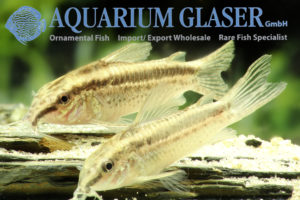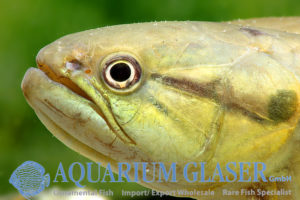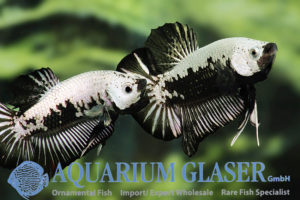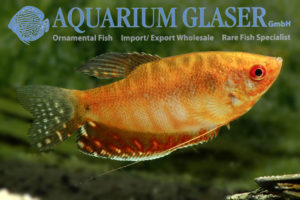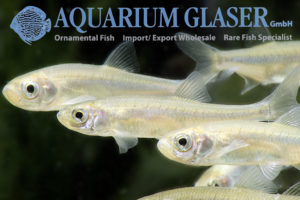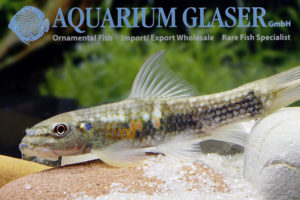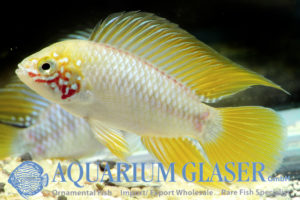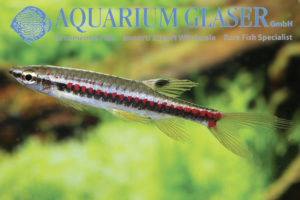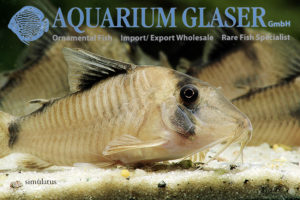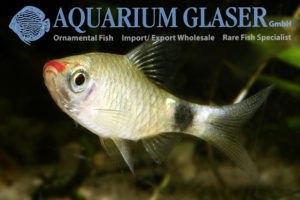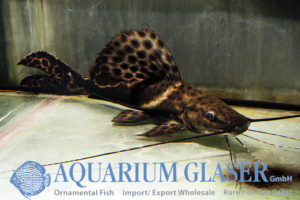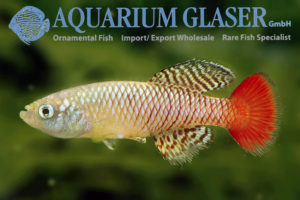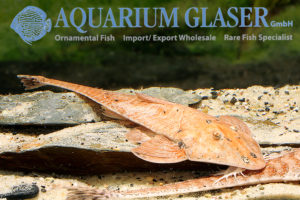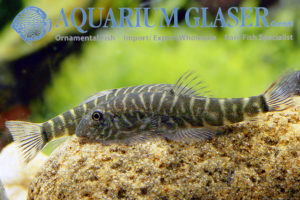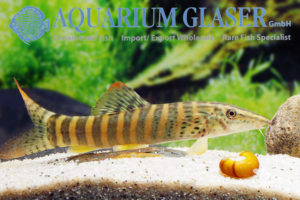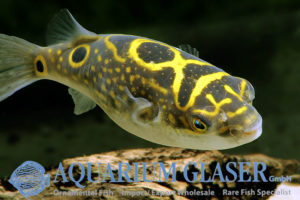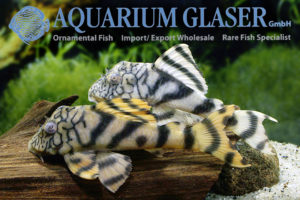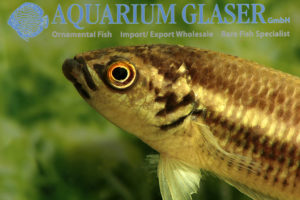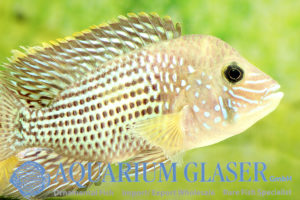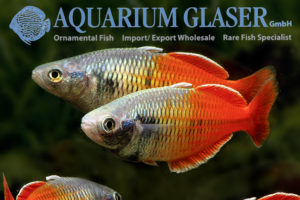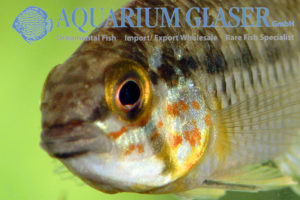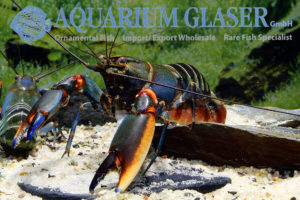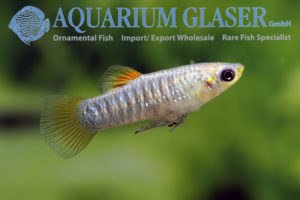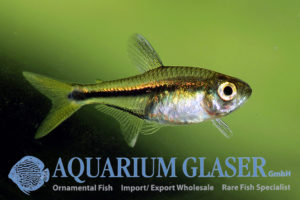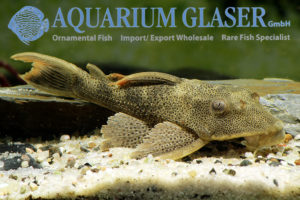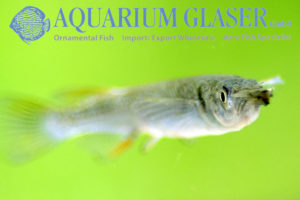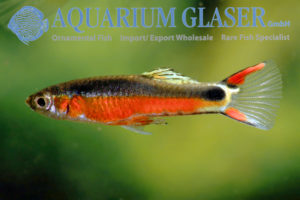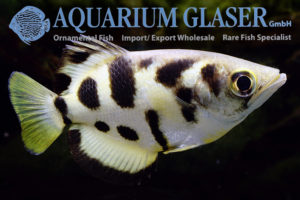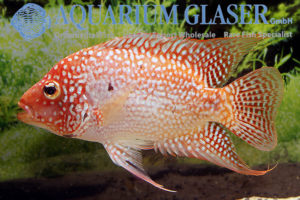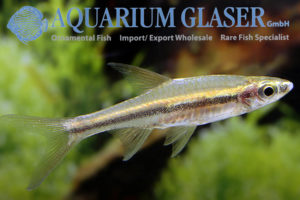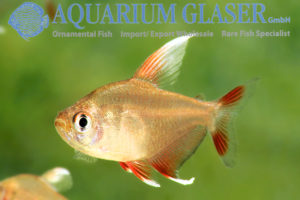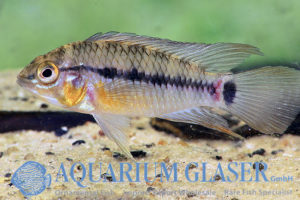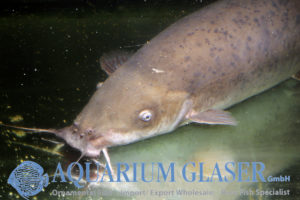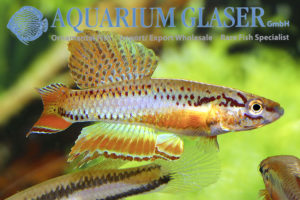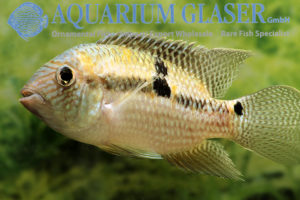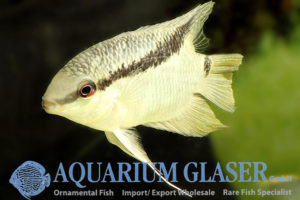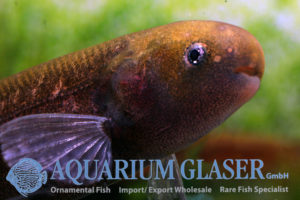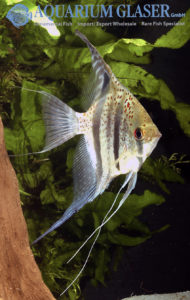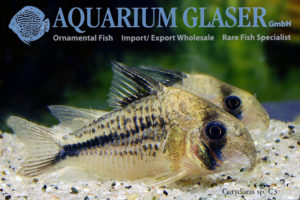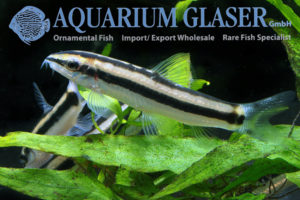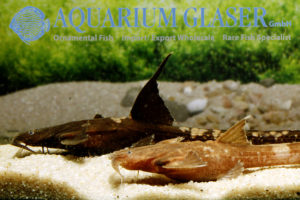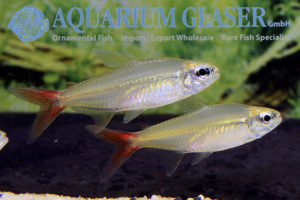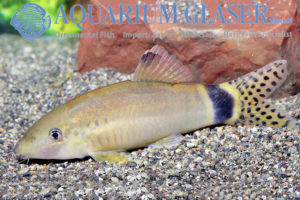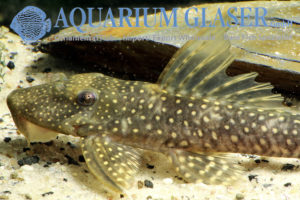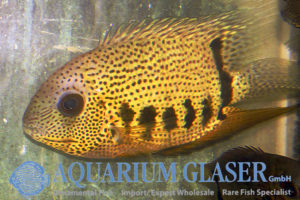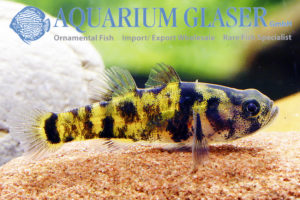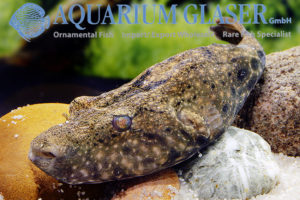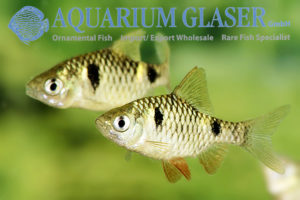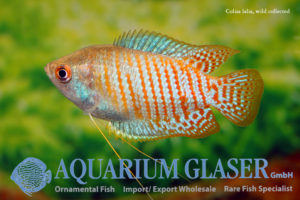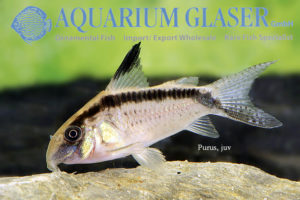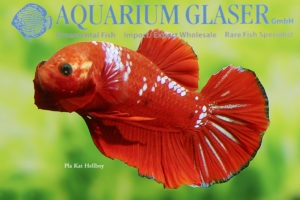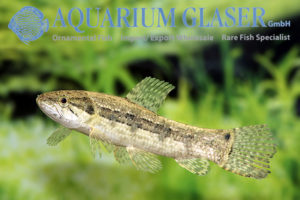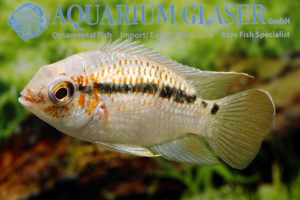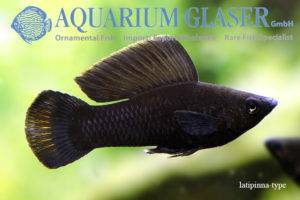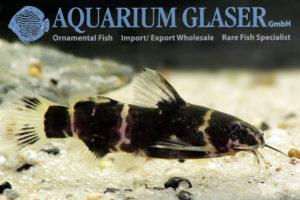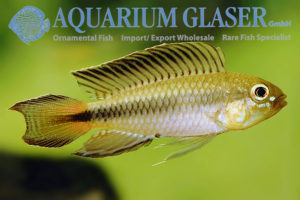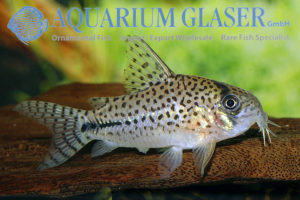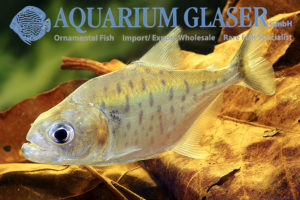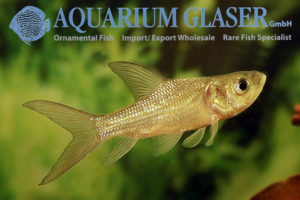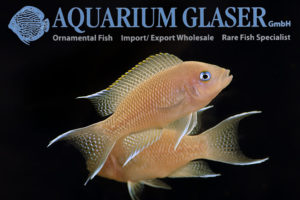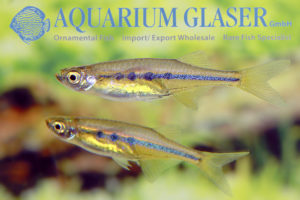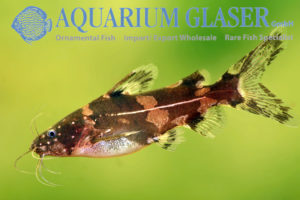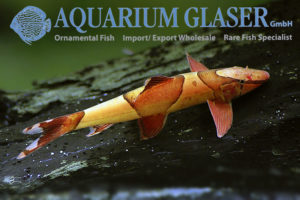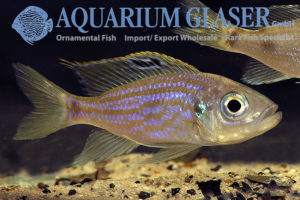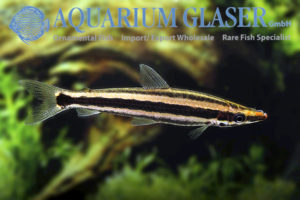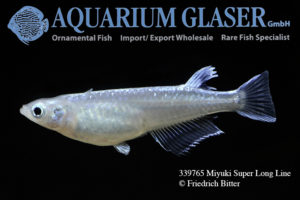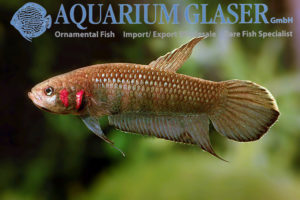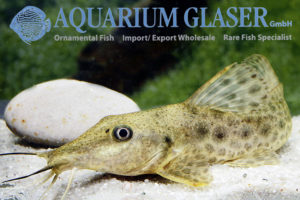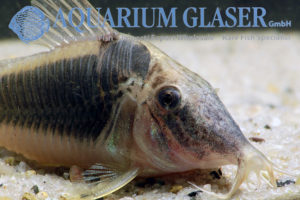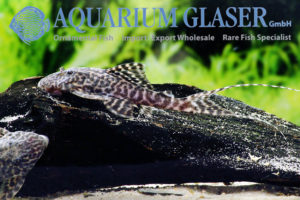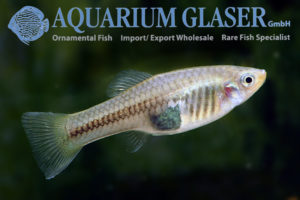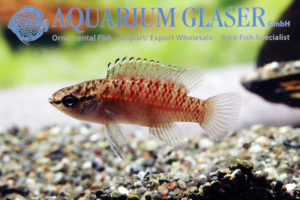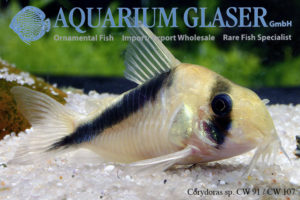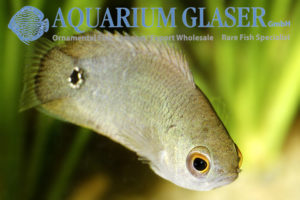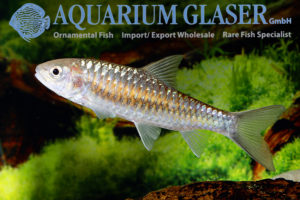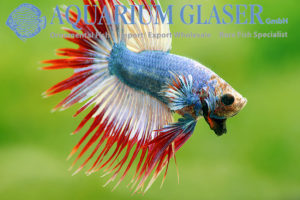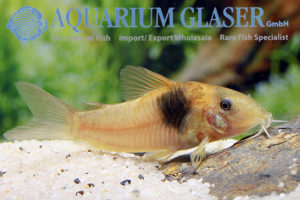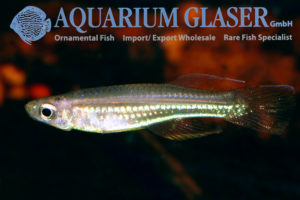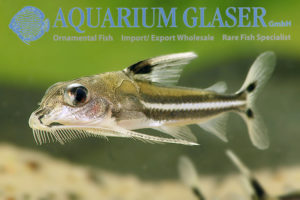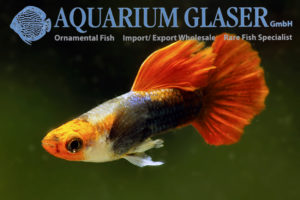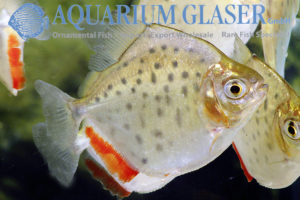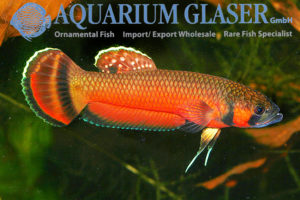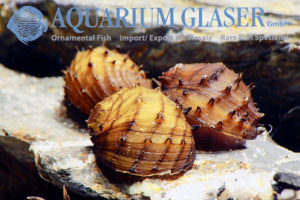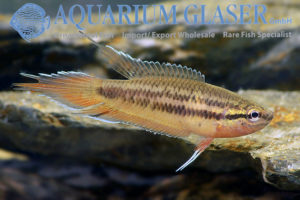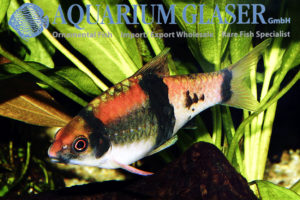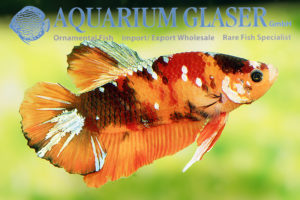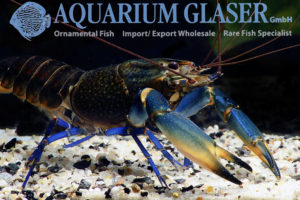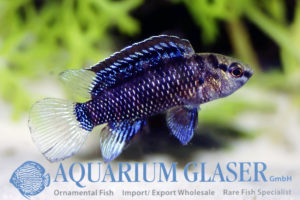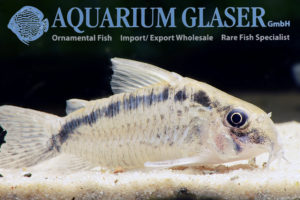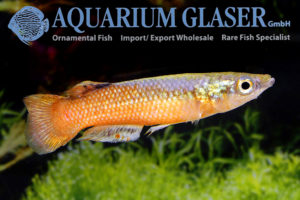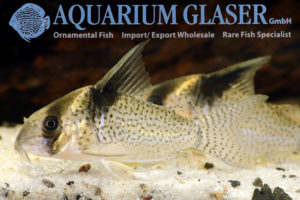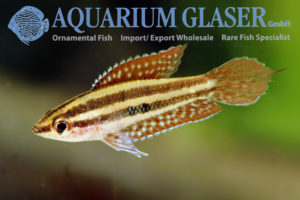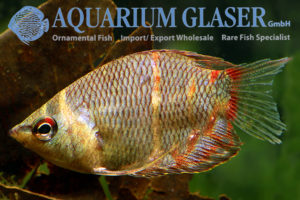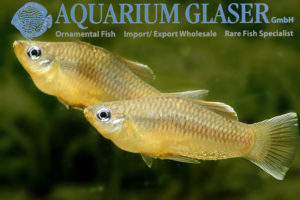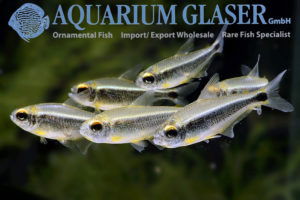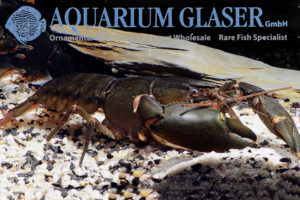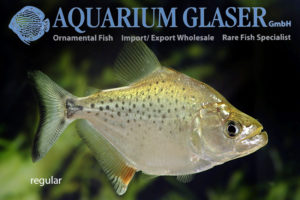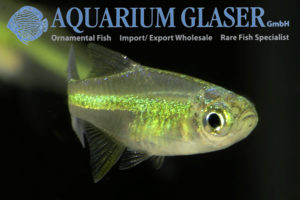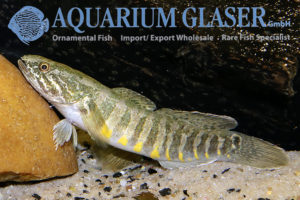The habitats of Corydoras gracilis in the entry of the Rio Madeira are clearly off the beaten track of ornamental fish collectors; furthermore, the nimble little animals, which know how to hide themselves perfectly in the maze of branches that have fallen into the water, are difficult to catch one by one. That is why […]
Fish Archive (3044)
-
-
Hoplerythrinus unitaeniatus “Orinoco”
From Colombia we received an import of the striped wolf tetra, Hoplerythrinus unitaeniatus. The systematics of these almost over the entire South America spread fish is poorly understood. Only the one species, H. unitaeniatus, is recognized commonly, but there are a lot of synonyms, among them the (without justification) occasionally recognized species H. cinereus (Trinidad […]
-
Betta splendens “Black Samurai”
Once again we have received a beautiful fighting fish breeding form, this time even in pairs: the animals are called “Black Samurai” in a melodious way. They are very lively fish, true temperament bolts, which actually deserve the name “fighting fish”. Excited males make little difference between males and females, both are heavily turned on. […]
-
Trichogaster trichopterus „Golden Red Eye“
The Spotted Gourami, Trichogaster trichopterus, is one of most widespread species of fish in Southeast Asia. Its range starts in the west at the burmese/thai border, it contents the Sunda islands and reaches in the East to China. Additionally the species has been introduced almost worldwide as a food fish in tropical climates. Crossing of […]
-
Leucaspius delineatus
The moderlieschen (Leucaspius delineatus) is the most recommended fish species for smaller garden ponds. Due to its miniature size of usually 4-5, rarely 8-12 cm it fits even for the smallest ponds, which must have, however, a minimum depth of 80 cm in central Europe to enable a survival during winter. The funky name […]
-
Garra sp. Sunset-Goldscale
We received once more this new, impressive species of Garra from India. The most striking feature of the species is that they have large, shining scales on the flanks. The position and number of these scales differs individually. Depending on the light these scales shine bright blue, orange-red or golden. The fully grown males (the […]
-
Apistogramma borellii “Opal”
We have received from a German breeder wonderful, fully grown Apistogramma borellii in two selections, “Opal” with red pattern on the head and “Reitzigi” with bright yellow head. With both forms, the males have dorsal fins of almost body height – fantastic animals! All photos of this post show animals of the “Opal”-form. For general […]
-
Copella nattereri
It took until the year 2006 that the tetra specialists Axel Zarske and Jaques Géry found out that the species described as Copella nattereri was practically not present in the hobby and that the red spotted Copella, which was named C. nattereri until then, was not known to science yet! So Zarske and Géry described […]
-
Corydoras simulatus
From Colombia comes the pretty long-snouted Corydoras simulatus. There it lives in the same rivers – the Rio Meta and its tributaries – as the round-snouted Corydoras metae. Because the latter have been known for a long time already, the scientific describers of C. simulatus chose the species name “simulatus”, in the sense of “only […]
-
Pethia (formerly Barbus or Puntius) erythromycter – Lipstick barb
This unique dwarf barb (max. 4 cm total length) from Burma has a red “moustache”. In males it is more pronounced than in females, but in P. erythromycter the ladies also have a moustache. Until its scientific description in 2008, the species was called Barbus cf. puntio. This species is best cared for at room […]
-
Hey, hey, hey, hey, little pirate…
This is the chorus of a Rodgau Monotones´ song about a small employee who breaks out of his hated everyday life and puts on an eye patch to continue living as a pirate in the future. We had to think of this song when a magnificent Leiarius pictus from Peru arrived on Wednesday. The animal […]
-
Nothobranchius palmqvisti
Yes, this pretty magnificent killifish actually writes itself “palmqvisti” and not, as one would think, “palmquisti”; this spelling with “v” was used in the first scientific description in 1907 and may not be changed. Palmqvists Nothobranch is an old acquaintance in the hobby and was first imported in 1958 and soon also bred with good […]
-
Sensational: Red Pseudohemiodon apithanos!
Recently we received red chameleon whiptails (Pseudohemiodon apithanos) from Colombia. The coloration of the eight specimens (a ninth was a “normal” apithanos, which we also received) is really fantastic. Red variants can be found in different loricariid catfish, think of Hemiloricaria and Ancistrus, but for the genus Pseudohemiodon they are not known yet. The individual […]
-
Gastromyzon viriosus
We were able to import this charming zebra hillstream loach from Indonesia. The determination of the numerous species of Gastromyzon from Borneo (more than 30 different species are known from the island) is quite tricky, many species look quite similar to each other. So we cannot exclude the possibility that our fish will proof to […]
-
Syncrossus berdmorei
The tiger loaches (Syncrossus) are a genus of comparatively large (about 15 cm), beautiful loaches. Formerly they have been added to the genus Botia. Currently five species are distinguished, among them Syncrossus berdmorei. Sadly this species is offered only occasionally, because it belongs to the most colorful species of the genus. The natural distribution of […]
-
Dichotomyctere ocellatus (formerly: Tetraodon biocellatus)
The green pufferfish (genus Dichotomyctere) are the best known aquarium pufferfish. They are brackish water animals, which, in case they should be cared for in fresh water, paying special attention to their pH value. A pH below 8 does not get them in the long run and the water should be as hard as possible. […]
-
Peckoltia sp. L135
Currently is season for one of the most beautiful members of the genus Peckoltia, namely L135. The species originates from the Rio Negro and can be easily recognized by the “wormline-pattern” on the head. Only two other species of Peckoltia show a similar pattern: P. braueri from the Takutu river and P. sp. L121 from […]
-
Betta pi
Why is an endangered, mouth-breeding fighting fish called like the mathematical circle number? Not so long ago, in 1986, the first of the these big fighting fishes was discovered in Malaysia by travelling labyrinth fish enthusiasts and described as Betta waseri in honour of Alfred Waser, a primordial rock of the labyrinth fish scene. These […]
-
Andinoacara rivulatus
Once colourful large cichlids were so popular that imports from Ecuador were organised mainly because of them. On the pacific side of the country live the “Green Terror”, so the then still Aequidens rivulatus named gold seam cichlids were called, and the “Red Terror”, then Cichlasoma festae, today Mesoheros festae. Both species become easily over […]
-
Melanotaenia boesemani Red
The blue-red Boesemans rainbow fish has not disappeared from the aquariums since its aquaristic discovery in 1981. For a time, it was so sought after that it was caught on a massive scale for export; these animals went almost exclusively to Japan, where were paid insane sums for them. There were even fears of overfishing […]
-
Apistogramma cf. taeniata
Nobody knows exactly what Apistogramma taeniata is, because the species was described in 1862 after a specimen, which is today in a very bad condition and the verbal description is more than scarce. At the time of the description, the genus Apistogramma did not yet exist, no one had any idea of its variety of […]
-
Cherax alyciae “Blue Kong”
This crayfish was regarded as a particularly pretty variant of the zebra-lobster (Cherax peknyi) until recently and was called “Blue Kong” in the trade melodiously. Chris Lukhaup, Rury Eprilurahman and Thomas von Rintelen described it scientifically as Cherax alyciae in June 2018. We have just received these very attractive animals as wild catches from Indonesia. […]
-
Poecilia (Limia) tridens
There is no agreement on the systematic position of the livebearers living on the Caribbean islands. According to anatomical characteristics, the genus Limia is today mostly regarded as synonymous with Poecilia, but they have so many independent characteristics that Limia is almost always mentioned as a subgenus. Aquaristically this is not so important whether Limia […]
-
A new little tetra from Peru
We admit it: when we unpacked the animals, we were just disappointed. Colourless tetras, obviously young, with a black longitudinal line. Quite great. Because of the round head form they reminded of the genus Bryconamericus, a very species-rich and difficult to overview genus, and because we had to book them somehow into the system, from […]
-
Hypostomus rhantos L242
With almost 150 accepted species, the genus Hypostomus (in the broadest sense) is the most species-rich group of loricariid catfish. Unfortunately, there is no current revision of all species and so the determination of Hypostomus is usually a laborious affair, in the end often only a questionable result. Hypostomus rhantos is pleasingly easy to recognize. […]
-
Dermogenys siamensis (D. pusilla)
The systematics of the widespread, small halfbeaks from South and Southeast Asia are complicated. A first revision of the genus by Mohr in 1936 summarized many previously described species under the synonymy of D. pusilla. This was followed by Brembach in 1991; the name D. pusilla was then used in the broadest sense. It was […]
-
Guppy Endler Cross “Santa Maria Bleeding Heart”
Since 2015 we know this very attractive Guppy, which is a cross of the species Poecilia reticulata and P. wingei and which is attributed to the Japanese breeder Kenichiro Tamura. From the common Guppy, this fish has inherited the more robust shape, especially of the females, and the less intense courtship behaviour, while the petiteness […]
-
Toxotes siamensis
We obtain some years already the very nice Toxotes sp. „Marble“ from Thailand, where it inhabits the Chao Phraya river. The up to 15-20 cm long species is a pure freshwater fish. It was very recently scientifically described as Toxotes siamensis now. During their research the authors found that only 2-3 of the currently 10 […]
-
Red Texas Cichlid
You may wonder why the title does not contain a scientific name. The reason for this is that the fish we are presenting to you was born from a crossbreed and crossbreeds do not have their own scientific name in zoological naming (unlike in botanical naming). The Red Texas Cichlid, which we offer as B-grade, […]
-
Trigonopoma gracile (= Rasbora taeniata)
We could import this pretty fish finally once more via Singapore. The two species of the genus Trigonopoma were placed in the genus Rasbora for a very long time. The second species, T. pauciperforata, the glowlight rasbora, occurs interestingly very often syntopically with its close relative. In the elder aquarium literature Trigonopoma gracile was usually […]
-
Hyphessobrycon “ornatus White Fin”
Among he longest-serving rosy tetras in the hobby is Hyphessobrycon ornatus, even if the species has a true odyssey concerning the naming behind it and is called Hyphessobrycon rosaceus according to the latest state of affairs; before it was equated with H. bentosi. The first specimens arrived already in 1933 from Guyana. Breeding was not […]
-
Apistogramma regani
This dwarf cichlid was scientifically described in 1980, long before it was recognized how enormously species-rich the genus Apistogramma is. The exact determination of this species is correspondingly tricky. It is essentially based on the pronounced zebra crossing, which the animals show above all when they are worried. The species is little known in the […]
-
Malapterurus microstoma 50 cm!
We usually get electric catfish from Nigeria in the form of the species Malapterurus beninensis. This is a medium sized species that grows to 20-30 cm in length. In April 2017 we received electric catfish from the Congo. From there 4 species are registered: Malapterurus monsembeensis (Syn: M. gossei), M. melanochir, M. microstoma and M. […]
-
Chromaphyosemion bitaeniatum LAGOS
This beautiful killi is only very occasionally available as German bred. Currently we have some of these bred ones in stock. They are descendants from the population from Lagos (Nigeria). Our fish are large, full in colour and very pretty. This species is suitable for community tanks with peaceful, small fish (barbs, tetras, catfish etc.). […]
-
Aequidens sp. Ventuari/Moriche
This beautiful and peaceful, somewhat reserved cichlid comes from Venezuela. It was collected in the Rio Ventuari, at a place where the river has to avoid the mountain Moriche. Mount Moriche is 1216 m high. Aequidens sp. Ventuari/Moriche is undoubtedly closely related to A. metae and becomes about 20 cm long. They are open breeders […]
-
Mesonauta sp. Manapiare
This beautiful flag cichlid (Mesonauta) comes from the Venezuelan federal state of Amazonas and there again from the administrative district Manapiare. Since it cannot be assigned without doubt to one of the Mesonauta species already described, the cichlid enthusiasts currently call it Mesonauta sp. Manapiare. As far as the care is concerned, this fish shows […]
-
Brienomyrus brachyistius
We obtained from Nigeria a species of mormyrid which we haven´t seen for years: Brienomyrus brachyistius. This comparably small species (maximum length reported is 17.cm, usually the fish becomes 10-12 cm long) is a close relative to the species B. niger, which we were also able to import again (see http://www.aquariumglaser.de/en/brienomyrus-niger_de_1152.html). The intelligent and playful […]
-
Pterophyllum scalare “Guyana Red Dragon”
The wild forms of the angel (Pterophyllum scalare) are enjoying increasing popularity, particularly the variants with locality information. Surely they are also cultivated; so come (or came, because there are currently hardly any exports from there) e.g. in wild catches from Guyana again and again especially many red spotted specimens. And who would blame the […]
-
Corydoras sp. C3
Shipments declared as “Corydoras bondi” from Colombia are always subject of surprise. The distribution of the real C. bondi is restricted to the Guyana countries. So sometimes Corydoras axelrodi, sometimes C. loxozonus, and sometimes the scientifically undescribed C. sp. C3 are shipped under that flag. This time we received the pretty C3. However, all three […]
-
Ambastaia nigrolineata: It doesn´t have to be always sidthimunki….
These dwarfish relatives of the clown loach have done a kind of odyssey in respect of the generic name in the past. Both were originally described in the genus Botia. Later they were placed in Yasuhikotakia. Only in 2012 they changed to the genus Ambastaia, which has been generated especially for them. This genus contains […]
-
Platystacus cotylephorus
We received this beautiful banjo cat from Brazil currently. The species represents by far the most desirable member of the family. The fish becomes approximately 30 cm long and thus should be kept in larger tanks. In contrast to most other banjo catfishes – which usually do not move if possible – this species is […]
-
Moenkhausia copei
From Venezuela we received a very nice color variation of Moenkhausia copei. The fish now look a bit like a stretched version of Moenkhausia collettii, where the shoulder spot so typical for M. collettii is missing and where the orange tail fin of M. collettii is red. We were able to import Moenkhausia copei for […]
-
Yasuhikotakia splendida
The genus Yasuhikotakia was separated from the genus Botia by Teodor Nalbant in 2002 and currently comprises 10 species. Some of them are important aquarium fish like Y. morleti (older synonym: Botia horae) and Y. modesta. The newest species on the ornamental fish market is Y. splendida, which was described as Botia splendida in 1995. […]
-
Pseudancistrus sidereus
Nasty people could say: another brightly spotted brown-black loricariid catfish. But the heart of real fans of this group of animals beats faster at the sight of the fish, which differs from all other L-catfish by the combination of the crescent-shaped dorsal fin and the tail fin coloration, which is actually typical for Lasiancistrus species. […]
-
Heros notatus BRAZIL WILD
We have received wonderful Heros notatus from Brazil. A typical feature of this species are the dark spots in the lower half of the body. As with all Heros the sexes differ by the head colouring, however, it is not always easy to distinguish a strongly coloured female from a male standing far below in […]
-
Brachygobius sp. Ocelot
Again we could import this new species of dwarf bumble-bee goby. This tiny fish becomes only 2 cm long. It cannot be applied to any described species so far. The fish have been collected in Indonesia. In Brachygobius, one very important feature for determination is the question wether the predorsal region is scaled or naked. […]
-
Pao suvattii (= Tetraodon suvattii)
This freshwater pufferfish originates from the rivers of Thailand. Here it imitates stones and lurks for clueless feeder fish. In the aquarium it can be easily fed by large pieces of frozen food given by a forceps. The fish becomes around 12-15 cm long and looks very much alike the African cousin Tetraodon miurus. However, […]
-
Pethia phutunio (= Barbus p.)
The dwarf barb has delighted aquarium enthusiasts since it was first imported from India in 1906. This is not so much due to its magnificent colouring; dwarf barbs are pretty, but no colour miracles. Rather, the tiny animal, which only grows to 2-3 cm in size in nature, fitted wonderfully into the formerly common, relatively […]
-
Colisa lalia
The dwarf gourami is the perfect ornamental fish. It unites magnificent coloration, a peaceful mind and an interesting behaviour. It becomes only 3 cm (wild caughts) or 6 cm (artifical bred sports) long and due to its calm habit it can be kept even in smaller tanks. And if it comes to feeding: the dwarf […]
-
Corydoras arcuatus “Purus”
The skunk cory is one of the most famous Corydoras species – you might think! In reality it is most probably a scientifically undescribed species, while Corydoras arcuatus – this scientific name is used for the skunk cory – is hardly ever on the market. But regardless of that: the regularly in large numbers available […]
-
Betta splendens “Pla Kat Hellboy” and “Giant Halfmoon”
Again our proven supplier from Thailand sent us some special Betta delicatessen. The Pla Kat Hellboy is a velvet red, short-finned fighting fish, very often with blue scales (there are also plain red ones). The very special thing about it: the also deep red colored pectoral fins. The Giant Halfmoon are real giants and have […]
-
Hoplias malabaricus German bred
For the first time we can offer this predatory tetra as German bred ones! Hoplias malabaricus is one of the most widespread species of tetra in South America; it is therefore suspected that it is more likely to be a number of externally very similar, so-called cryptic species. The offspring was bred with a pair […]
-
Krobia xinguensis
This pretty cichlid has been described scientifically only in 2012. Up to that time it was known among hobbyists under the name of Krobia sp. “Xingu Red Head”. This nice relative of Aequidens is the ideal cichlid species for beginners, because it is one of the most peaceful species of cichlid at all. Besides this […]
-
Black Molly = Black Molly?
Sometimes we also take a closer look at the everyday species; one tends to judge fish like the Black Molly in trade only according to the aspects: 1. are the fish healthy and stable? and 2. are they well grown? But Black Molly is certainly not the same as Black Molly. Depending on which wild […]
-
Microsynodontis batesii
Squeakers or upside-down catfishes are a fish family occurring exclusively in Africa. The best known genus is Synodontis, which comprises over 130 species. Closely related to this genus is the genus Microsynodontis. The genus name means “small Synodontis” and is program, because these fish already become sexually mature with 3-4 cm of length, are thus […]
-
Apistogramma uaupesi
Apistogramma uaupesi is certainly one of the most beautiful dwarf cichlids. Adult males can be very variable colored, therefore A. uaupesi got several German popular names, like “Rotkeil-Apistogramma” or “Blutkehl-Apistogramma” (= Red Wedge and Blood Throat). In nature, however, all color variants occur together, so it is not a matter of locality forms, but of […]
-
Corydoras sp. C91
We received beautiful Corydoras sp. C91 from Peru (Rio Huallaga). The splendid species belongs to the closer relationship of Corydoras julii, C. punctatus, and C. trilineatus. The species was called Corydoras sp. “Heiko” or C. sp. “Peru-Bondi” in the trade before it was given a C-number. The peaceful schooling species gets the most brillant colours […]
-
Serrasalmus manueli
This piranha, described from Venezuela, is easily recognizable by its characteristic pattern in connection with the head profile, but still causes great confusion, as the fish in the trade come from completely different areas and are still indistinguishable. S. manueli was described as Pygocentrus manueli from the Río Paraguaza, middle Orinoco, Venezuela. The first description […]
-
Catlocarpio siamensis
The Giant Carp (Catlocarpio siamensis) is the biggest carp of Southeast-Asia with allegedly up to 3 m of length. However, such large animals have never been scientifically confirmed. The largest documented specimen was “only” about 150 cm long. In nature the Mekong giant carp is probably extinct or at least very, very rare. Fortunately, the […]
-
Neolamprologus marunguensis
Currently we can once again offer the little blue-eyed sister of the Princess of Burundi: Neolamprologus marunguensis. The beautiful dwarf cichlid from Lake Tanganyika belongs to the problem-free ornamental fish. As with all princesses, one can frequently observe multiple broods, with what the older siblings take part in keeping of the small young animals. Therefore, […]
-
Chela dadiburjori (= Laubuca dadiburjori, = Neochela dadiburjori)
This nano gem reached us from the south of India; the charming dwarf fish reaches a maximum size of 3 cm. It is an absolutely peaceful schooling fish that spawns on the upper side of broader leaves of submersed plants – Ludwigia-species are preferred. On our stocklist this species was intially written as dadyburjori; so […]
-
Pseudomystus funebris
Again we could import a cute blackwater dwarf catfish from Indonesia, this time from Borneo. Pseudomystus funebris was only scientifically described in 2010 and is extremely similar to P. heokhuii which occurs on Sumatra. Like the latter, it reaches a total length of about 6 cm. The species is very peaceful and also constantly on […]
-
Homaloptera parclitella
Hillstream loaches belong to the family of loaches. Probably the most beautiful species can be found in the genus Homaloptera. There are several closely related and similar looking species. In the German one calls it often “saddle-stain-loaches”, English, the animals become “lizard loaches” called. Homaloptera parclitella is an extraordinarily beautiful hillstream loach from the black […]
-
Aulonocranus dewindti
This interesting cichlid, the genus is monotypic with Aulonocanus dewindti, so currently only this one species is assigned to it, originates from Lake Tanganyika. The up to 14 cm long species is a mouth-breeder in the female sex and lives in the lake over sandy areas. Here the males dig pits in the sand, that […]
-
Anostomus ternetzi
The golden striped headstander, Anostomus tenetzi, has a very wide distribution in South America. It is recorded from Brazil, French Guyana, Guyana, Suriname, and Venezuela. The specimens on which the original descritption based, originated from Venezuela, and we were able to import them from there once more. This beautiful fish is among the most peaceful […]
-
Oryzias latipes – Medaka breeding forms
The care and breeding of the Japanese Rice Fish or Medaka has a very long tradition in Japan. Already around 1900 gold-colored Medakas were mentioned in the aquaristic literature. The breeding of these small fish is currently experiencing a renaissance in Japan. Friedrich Bitter drew attention to this and also imported many of these forms […]
-
Betta foerschi bred
The fighting fish of the Betta foerschi relationship – there are several very similar species, which are considered by some specialists to be only local varieties of the same species, namely Betta foerschi – are not only particularly beautiful, but also particularly interesting. They are mouth breeders, but they are, so to speak, at an […]
-
Auchenoglanis sp. Niger (A. biscutatus)
Until recently only two species of Auchenoglanis were recognized as vaild: A. biscutatus from the Nile and the whole of West Africa and A. occidentalis from Central Africa. But in 2010 the genus was revised by Retzer, who accepted a total of 8 different species, 7 already described formerly and one new species, namely A. […]
-
Pterophyllum „Santa Isabel“
We can offer just wonderful, young adult German bred offspring of the famous Santa-Isabel-Angel, which differs clearly from other wild collected angels by its attractive red coloration at the front-back. The animals are descendants of fish that we were able to import as wild catches some years ago (see: https://www.aquariumglaser.de/en/fish-archives/fantastic_pterophyllum_scalare_santa_isabel_arrived__en/). Especially worth mentioning is – […]
-
Corydoras Rarities
From Peru we received samples of some top rarities among the armored catfish. All belong to the group of long snouts, which in contrast to the round snouts do not live in swarms, but have to be laboriously collected individually. The species, called by the exporter as Corydoras sp. as “Melita”, belongs to the immediate […]
-
Panaqolus sp. L351
From Peru comes a Panaqolus, that is charcterized particularly through the small eye and the long tail fin filaments. With L351 they got their own code number. Unfortunately L351 is imported only very rarely, because most photos of this species show a darkly colored, unattractive fish. In reality, the animal is very nicely colored after […]
-
Xiphophorus andersi
Once again we can present and offer you a top rarity among the wild forms of livebearers: Xiphophorus andersi. Most likely the animals we have received from a German breeder are the first ever to be offered in the ornamental fish wholesale trade. Xiphophorus andersi comes from the Rio Atoyak in the state of Veracruz, […]
-
Dario kajal
The first reports of a new dwarf badis appeared in June 2004. Nonn Panitvong, an enthusiastic Thai aquarist, had found the animals in Bangladesh. Panitvong did not announce a more precise location, but said he caught the animals in a pond near a rice field, together with Danio rerio, Oryzias sp., Channa sp., Colisa chuna […]
-
Corydoras CW 89 / CW 91 / CW 106 / CW 107
From the Rio Vaupes in Colombia we have received a few specimens of two Corydoras species. These are real rarities. Corydoras sp. CW 107 reminds of Corydoras davidsandsi and we think it is the same species as Corydoras sp. CW 91. The long snouted counterpart of Corydoras sp. CW 107 is Corydoras sp. CW 106, […]
-
Ctenopoma breviventrale
Why should one keep grey fish? Some may ask themselves this question when looking at the pictures of this bushfish from the Congo. The answer is: the urge to explore! Unfortunately, many animal and plant species die out every day. Also many freshwater fish are strongly threatened by environmental changes – other factors such as […]
-
Neolissochilus stracheyi – Blue Tor
Once more we have this splendid large barb (maximum size: approx. 60 cm) from Burma in stock. We have only a limited number of specimens! If one photographs these fishes and sets the flashlight directly from the front the fish looks rather drab silvery. But in the real life, when the fish is swimming, the […]
-
Betta splendens “Crown Tail Thai Flag”
Three-coloured fighting fish have been around for many decades, they are usually called “Butterfly Bettas”. At the moment we have some specimens of a not only beautiful, but also symbolic Betta breed in stock, which are dyed in the national colours of Thailand! According to Wikipedia, the current flag of Thailand, a tricolour with five […]
-
Corydoras sp. CW 16 “teniente”
Recently we received a shipment of highly interesting fish from the entry of Madre de Dios in the border area between Peru and Bolivia. Among them were beautiful corydoras catfish from the closer relationship of Corydoras melanotaenia. However, it is certainly a scientifically undescribed species, which was documented by Ian Fuller with the code number […]
-
Aplocheilichthys luxophthalmus (= Poropanchax luxophthalmus)
Currently we were able to import once more one of the most beautiful lampeyes from Nigeria: Aplocheilichthys luxophthalmus. Those who follow the splitting of the genus Aplocheilichthys place the maximum 3 cm long fish in the genus Poropanchax. A. luxophthalmus is a schooling fish that should never be kept in groups with less than ten […]
-
Tenellus trimaculatus
From Peru we have received this nice catfish, which can be recognized by its species-typical pattern: A black spot at the base of the dorsal fin, two at the middle base of the caudal fin. The species name also refers to this (trimaculatus = with three spots). The peaceful animal becomes about 10 cm long. […]
-
New highly selected guppys: Koi Red Tuxedo Red Nose and Full Black
In this case “new” does not mean that there were no colour varieties like this before, but that we have a new breeder, who gives us these and other high end breeding guppies in pairs and colour hits, so that we can pass on really fantastic animals. Of course there is also a certain variance […]
-
Metynnis maculatus
There are two rather similar species of the silver dollar genus Metynnis with a pattern of black spots. They differ mainly by the (externally not visible) number of the gill rakes and the number of scales along the long side of the body, but also somewhat in relation to the body shape. We currently call […]
-
Betta macrostoma
For sure Betta macrostoma is one of the most beautiful species of fighting fish – and the most sensitive! There is hardly another known species of fish that becomes that easily infested by bacteria of any kind. Many breeders of Betta macrostoma use UV filters the whole year through to avoid bacterial development in the […]
-
Neritina juttingae
The Neritina snails are enjoying growing popularity among aquarists. There are several reasons for this. The most important one is certainly that they look attractive. In addition, Neritina snails do not reproduce in freshwater aquariums, as the larvae only develop in the sea. The third important reason for the popularity is that Neritina snails also […]
-
Pseudosphromenus dayi
The red spike-tail is a classic among the aquarium fish and is and is not missing in any manual of ornamental fish science before the Second World War. But its origin was always mysterious, the original description from the year 1909 was based on aquarium imports. Today it has become quiet around him and his […]
-
Haludaria fasciata, the melon barb (formerly: Barbus fasciatus)
In the south of India rises the ancient high plateau of the Deccan, which was already formed when India was still part of Africa. From here numerous small rivers flow directly into the Indian Ocean and in many of these rivers own colour variations, subspecies or species of freshwater fish have formed due to the […]
-
Betta splendens „Emerald Candy“
This is the latest Betta creation from Southeast Asian breeders. A multicoloured short fin, where matte scales and emerald green shining body and fin parts contrast wonderfully with each other. For the first time we have received a hand-picked selection of this new breed from Betta splendens „Emerald Candy“. For our customers: the fish have […]
-
Cherax sp. Blue Moon Black Body / Black Scorpion Blue Leg
The variety of colours of the crayfish on New Guinea is really amazing. In the trade it is often problematic to assign the import animals exactly to any species, because the colouring is also very variable within the species and only rarely all specimens of an import look the same. Be that as it may: […]
-
Badis badis
The blue perch is a classic among aquarium fish and has been in the hobby for over 100 years. The maximum length of the peaceful animal is 5 cm. Males in courtship display are almost black with sometimes blue shimmering fins, in neutral colouring the animals are reddish brown with vertical black bandages (which can […]
-
Corydoras cf. urucu
Once again we were able to import a new catfish, whose identity raises many questions. The fish were offered to us as Corydoras evelynae, a species that was described by only one specimen with a very inaccurate location (“upper Solimoes”, which includes an area larger than Germany). Our new imports were collected in the surroundings […]
-
Pachypanchax sakaramyi – one of the rarest fish in the world
Although the species Pachypanchax sakaramyi – it originates from the Sakaramy River on Madagascar – was described as early as 1928, it could not be found for decades afterwards and even was referred to the realm of legends. It was not until the 1990s that they were found again. From these animals (5 pairs), which […]
-
Corydoras sp CW 98
This beautiful Corydoras belongs to a scientifically undescribed species. It originates from the upper Rio Negro in Brazil. Because of the bright orange neck spot it is usually misidentified as Corydoras burgessi, which also comes from this region, especially as C. burgessi has a very variable pattern and there are also spotted colour variants of […]
-
Parosphromenus linkei
The magnificent licorice guramis (Parosphromenus) have experienced a species explosion in recent years. Until 1979 only three species were known, today there are 20 scientifically described species and some more undescribed ones are already known in the hobby. Unfortunately, many are threatened with extinction because they live in peat swamps and these habitats are drained […]
-
Sphaerichthys osphromenoides
From Indonesia we received beautiful, very large and strong chocolate Guramis (Sphaerichthys osphromenoides). Unfortunately the exact place of origin is not known, but we suspect that they come from the Indonesian part of Central Borneo, Kalimantan. Particularly noticeable in the animals is their high red portion in the coloration, which is however somewhat different with […]
-
Priapella compressa
The Blue-eyes from Mexico are closely related to the Knife-bellies (Alfaro). Like these, the males of Priapella have a massive keel along the underside of the tail. All Priapella attract attention by their blue, shining eyes. They are powerful swimmers who appreciate a good current. In nature they live close to the surface in clear […]
-
Moenkhausia heikoi
For the first time we could import, even if only in very limited numbers, this tetra from the Rio Xingu described only in 2004. The animal became known in 2001, when Rainer Stawikowski presented the fish as “Hemigrammus sp. Xingu” in the journal DATZ. The scientific description took place in 2004, twice and almost simultaneously: […]
-
Cherax sp. „Black Scorpion“
Along with other species of Cherax,, which we have already introduced to you, we have received the Cherax sp. “Black Scorpion”. They are very attractive animals whose care and breeding does not differ significantly from that of the previously known Cherax forms from New Guinea. For our customers: The animals have code 481473 on our […]
-
Serrasalmus compressus – a very interesting piranha from Peru
Recently we obtained a shipment of piranhas from Peru. The fish are 5-9 cm long. At the first glimpse the shipment could be told apart into two phenotypes. First, there were fish with comparatively small spots, a lot of red coloration in the anal fin and a comparatively thin black border on the caudal fin. […]
-
Microdevario kubotai
Microdevario kubotai This extraordinary beauty is a real dwarf (maximum length around 2.5 cm). It originates from the southwestern province of Ranong in Thailand (which forms a border to Burma) and is now available in perfect quality. Initially this fish has been described in the genus Microrasbora, but has been transferred together with M. gatesi […]
-
Bostrychus zonatus
Bostrychus zonatus is a sleeper goby and becomes about 15 cm long. They are predatory fish, which should therefore only be kept together with species that have at least half the body length of the gobies, larger is safer. The beautiful animal is widespread in fresh and brackish water in New Guinea and northern Australia. […]
- « Previous Page
- 1
- …
- 10
- 11
- 12
- 13
- 14
- …
- 31
- Next Page »





